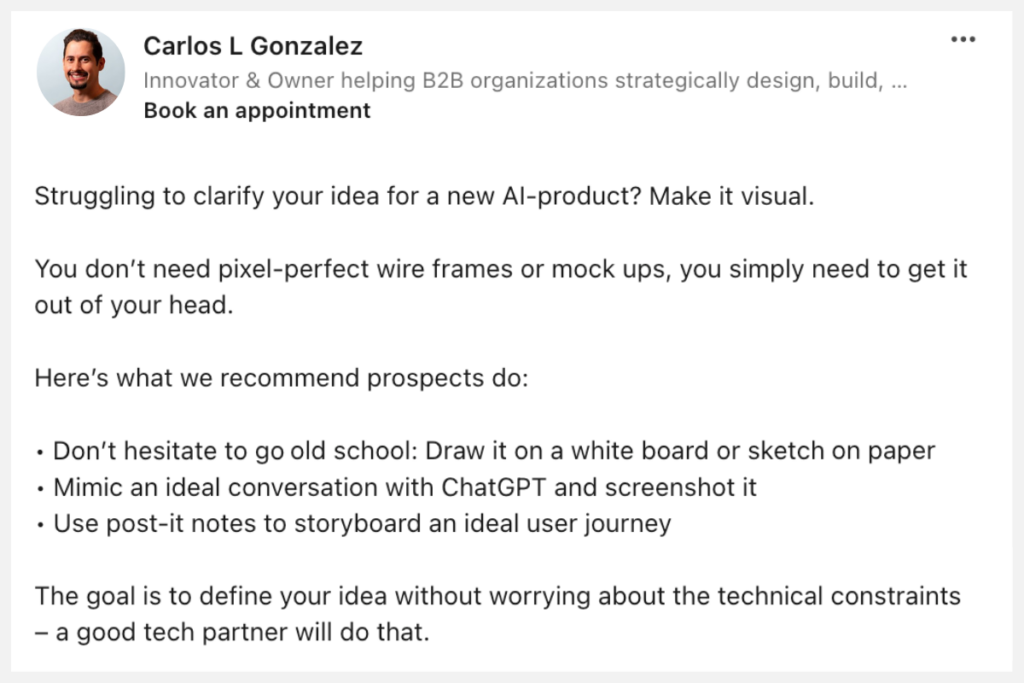It’s the start of Q4, and the race is on.
While most leaders are focused on finishing the year strong, the forward-thinkers among us are already eyeing new market share in 2025.
After a decade of partnering with industry leaders, from F500s to startups, we’ve learned the secret to new revenue often lies in transforming your proven service into a SaaS product.
This pivot can open up new sales opportunities, increase scalability, and maintain a competitive edge.
But here’s the challenge – knowing how to capitalize on your domain expertise isn’t always straight forward.
To help you spot the hidden gems within your offerings, we’ve crafted this insider’s guide of telltale signs that it’s time to develop a new product, along with tips on how to get the ball rolling.
6 Signs It’s Time To Pivot A Service To SaaS
1. You’re consistently solving the same problem for clients.
2. You’ve developed a unique solution to a widespread industry problem.
3. Your service processes are highly repeatable & increasingly automated.
4. Your services create a natural upsell or cross-sell potential that a product could fulfill.
5. You have deep domain expertise that could be leveraged into insights for your clients.
6. You have a robust network of potential early adopters who view you as a thought leader.
If you recognize one or more of these signs in your organization, you might be wondering, ‘ok, now what?’
Based on our 10+ years of bringing SaaS products to market, we’ve put together a simplified version of our internal playbook for successfully going from 0 to launch.
Here’s what we recommend:
Step 1. Validate Your Idea
Validating your idea reduces the risk of building a product nobody wants, saving you time and resources in the long run.To truly validate your idea, you’ll want to complete these substeps:
• Do market research
• Conduct customer discovery
• Run competitor benchmarking
• Identify your key differentiators
Next, you’ll want to take your learnings and…
Step 2. Make It Visual
Building software requires getting clear about your vision.
Visual representations help identify potential issues early, align stakeholders, and accelerate development by providing a clear roadmap.
3 of the most impactful processes you can use are:
1. Map the user experience (UX)
2. Create a clickable prototype
3. Performing user testing

Need to move fast? We’ve got you covered.
Our team can guide you through our proprietary Big Bite Define & Design Framework.
It’s like a GPS for your product journey, helping you nail down the essentials, avoid common pitfalls, and accelerate your development timeline.
The best part? This process sets you up for a smooth build, whether you choose to partner with us or not.
Step 3. Identify Your MVP
An MVP allows you to test your concept with minimal investment, gather valuable user feedback, and iterate quickly.
First, you’ll need to select the minimum feature set that provide genuine value for your customers.
Then, choose the MVP type that best fits your product and resources:
• Simple App: A basic version with core functionality
• Clickable Prototype: A non-functional visual representation
• Concierge MVP: Personalized service delivery to test concept
• Wizard of Oz MVP: Manual backend processes simulating automation
If you’re not sure which is the best MVP for your needs, check out our break down on the different types of MVP.
Once you’ve identified your MVP, the next crucial step is to test it internally.
Step 4. Use Your Product Internally
Internal use allows you to identify and fix issues before they impact customers, refine your product, and build a strong case study for external clients.
Here’s a simple framework to get you started:
• Set up a 2-week internal testing period
• Assign specific testing scenarios to team members
• Conduct daily stand-ups to discuss findings
• Document all bugs and user experience issues
After thoroughly testing your MVP, you can begin transitioning existing clients to your product with hands-on support.
Step 5. Seek Early Adopters
• Get soft commitments or signed LOIs from existing customers
• Reach out to your network to build interest and momentum
• Gather testimonials and create case studies


